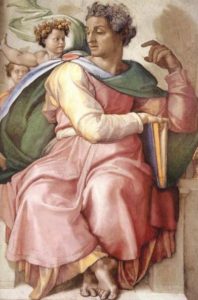Isaiah and Hezekiah 715-687, Teddy Kollek and Moshe Pearlman, Jerusalem: Sacred City of Mankind, Steimatzky Ltd., Jerusalem, 1991.
 Isaiah grew up and dwelt in Jerusalem, living with its sights and sounds and patterns for some fifty years. He was familiar with and conditioned by its history. This was his heritage. In return, he was to give Jerusalem—and, through Jerusalem, to civilization—a prize of measureless worth, powerful moral precepts in sublime language. His concern was immediate and local—developing Jerusalem’s spiritual forces, rallying her military strength, arresting her threatened destruction. The impact was timeless and universal.
Isaiah grew up and dwelt in Jerusalem, living with its sights and sounds and patterns for some fifty years. He was familiar with and conditioned by its history. This was his heritage. In return, he was to give Jerusalem—and, through Jerusalem, to civilization—a prize of measureless worth, powerful moral precepts in sublime language. His concern was immediate and local—developing Jerusalem’s spiritual forces, rallying her military strength, arresting her threatened destruction. The impact was timeless and universal.
Over all this hangs the grim threat of invasion. Isaiah, through his burning words, rouses the king and people to meet it not only by making the fortifications more secure, but above all by a strengthening of the spirit. He emphasizes the moral and religious significance of Jerusalem, the spiritual fountain it was and must again become, “the faithful city…full of judgment [and] righteousness.” It has been debased, but the Lord has not forsaken it. Later, when the battle is joined, his words take on a crucial urgency—and, at the critical moment, decide the issue.
Meanwhile, Hezekiah got to work on the physical strengthening of Jerusalem. The new Assyrian ruler, Sennacherib, was smashing his way even further southwards, and although Hezekiah could and did put off the confrontation by various alliances with kingdoms equally threatened by the Assyrians, he knew that eventually Jerusalem would be attacked.
It is evident from the Bible that he was much preoccupied with the water system, and from this ancient record—as well as from a remarkable archaeological discovery some ninety years ago—we know that he devised a plan to secure his own water supply and a t the same time deny water to the enemy. However strong his fortifications, he would never withstand siege if his water ran out. By the same token, a besieger could not long maintain his pressure on the city if, in the arid surroundings in which his men would be encamped, the main local source of water were cut off.
Hezekiah accordingly “made a pool, and a conduit, and brought water into the city” (II Kings XX, 20). He “also stopped the upper watercourse of Gihon, and brought it straight down to the west side of the city of David” (II Chronicles XXXII, 30). Gihon, as we have seen, was at the foot of the eastern wall and was the main source of the city’s’ water. What Hezekiah did, therefore, was to seal the Gihon cave in which the spring issued, thus denying it to an invader. At the same time, he cut a 600 yard tunnel (preserved to this day) which led the water under the southeastern part of the city and out to a reservoir or pool inside the city at a point where the ground is lower. This is known as the pool of Siloam (or Shiloah).
In 1880, the biblical record was confirmed by the discovery in the rock wall of the lower entrance to the tunnel, south of the Temple area, of a Hebrew inscription on how the underground passage was excavated. The language is perfect classical Hebrew prose, its contents and script pointing to the reign of Hezekiah. The words were inscribed on a prepared surface of the wall, like the surface of a tablet, but the top part of the inscription was missing. Six lines alone remained, enough to tell the story of how the tunnel was dug by two teams of miners starting at opposite ends, working towards each other and meeting in the middle. It is known as “The Siloam [or Shiloah] Inscription.” In its standard English translation, it reads as follows-
“[…when] (the tunnel) was driven through. And this was the way in which it was cut through- — — while […] (were) still […] axe(s), each man toward his fellow, and while there were still three cubits to be cut through, [there was heard] the voice of a man calling to his fellow, for there was an overlap in the rock on the right [and on the left]. And when the tunnel was driven through, the quarrymen hewed (the rock), each man toward his fellow, axe against axe; and the water flowed from the spring toward the reservoir for 1,200 cubits, and the height of the rock above the head(s) of the quarrymen was 100 cubits.”
In the year 701, Sennacherib struck. The powerful Assyrian monarch had already accomplished a victorious march southwards and reduced all the territories to the west, north and northeast of Judah. He had also cut deeply into the Hebrew kingdom and had “come up against the fenced cities of Judah, and took them.” Jerusalem alone remained. Sennacherib now proceeded against it.
The mighty conquests which had brought him so close to Jerusalem coupled with the sacking of all the other principal cites of Judah, prompted Sennacherib to attempt to cow Hezekiah into surrender without having to fight. He sent his Chief Minister Rabshakeh together with an army which encamped near the ramparts of the city, and they tried with threatening words to demoralize the Jerusalemites into submission.
Hezekiah sought advice from Isaiah, and it was the prophet’s rallying words which stiffened his people’s resolve to resist and saved Jerusalem. The biblical record condenses them into a few sentences. His key exhortation was- “Be not afraid of the words which thou hast heard.” The surrender appeal was spurned. The siege was withstood. The attackers eventually left and returned to the Assyrian capital.



